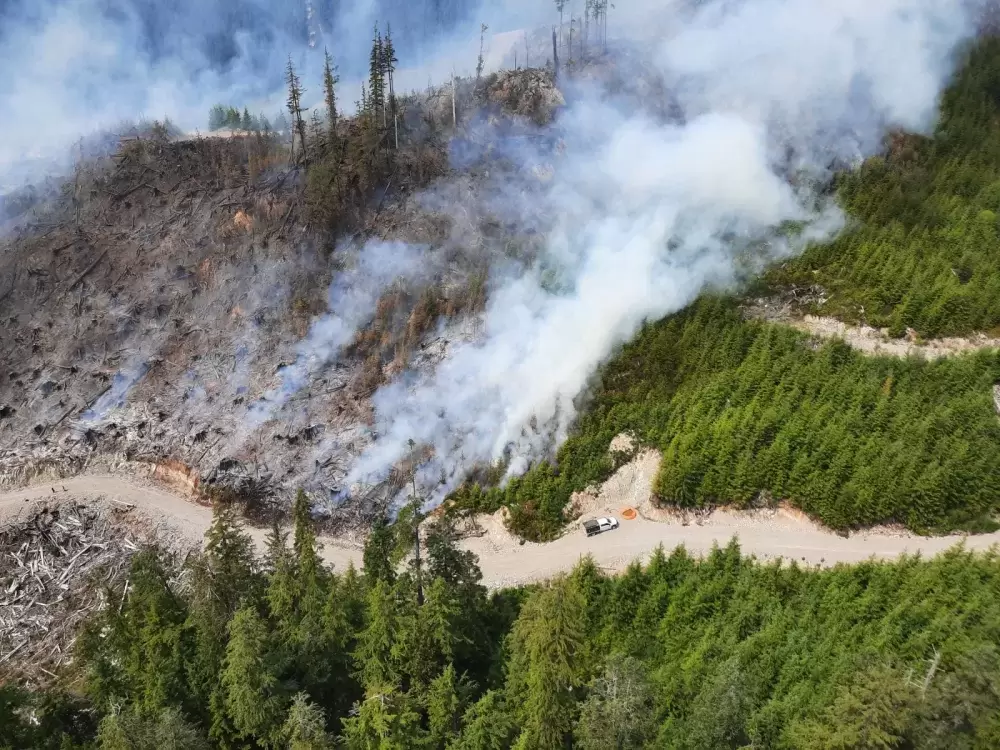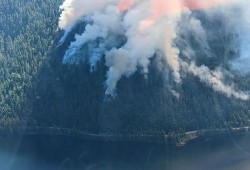This year, before students even closed their books for the summer, forest fires sparked throughout the region.
The Cameron Bluff fire, which is believed to have been human-caused, grew to 229 hectares, closing Highway 4 for most of June - the only highway in and out for many West Coast communities.
One month later, the 16.6-hectare Klanawa River fire was discovered in what Huu-ay-aht Chief Councillor John Jack referred to as the shared territory between his First Nation and Ditidaht.
Though both fires are currently under control, Vancouver Island has reached drought Level 4 and an “extreme” fire rating, leading the province to prepare for an increase in lightning-caused fires.
According to the BC Wildfire Service, these conditions cause fires to start more easily and spread rapidly, bringing challenges for suppression efforts.
“It’s quite bad right now,” said Nick Donnelly, an information officer with the Coastal Fire Center.
“We haven’t had really much precipitation of note in the last little while,” he added. “Things are just very dry and susceptible to fire.”
“We are anticipating continued extreme fire behavior,” said Bowinn Ma, minister of Emergency Management and Climate Readiness, at a press conference. “All of us need to do our part to prevent the situation from becoming any worse.”
Over the second weekend of July 115 additional wildfires from dry lightning impacted all regions of the province, she said.
Ma said that the recent increased lightning activity was compounded by ongoing drought conditions and high temperatures.
“Human-caused wildfires are completely preventable and divert critical resources away from lightning-caused fires,” said Ma.
“Fire smart your home, clean your gutter, mow your lawn, and make sure anything combustible, such as wood piles, are stored at least 10 meters away from your house,” continued Ma. “It is also important that people are aware of and follow fire bans and prohibitions in their area.”
Effective at 3 p.m. July 10, the Ministry of Emergency Management and Climate Readiness declared a prohibition of category one campfires in all areas of the province, with the exception of Haida Gwaii, announced Ma.
The minister also encouraged all British Columbians to prepare an emergency plan, including a grab-and-go bag with plenty of water.
“Every year it's scary,” said Paul Sieber, Ditidaht’s natural resource manager at Nitinaht lake. “I personally am afraid that we're going to get one close to our community one day and we really are not prepared for it.”
Sieber explains that there are limited routes in and out of the community.
“There’s only the road to Duncan and the road to Port Alberni… [and] there is one more road, we call it the backway,” said Sieber.
“We actually have to do a lot of work for all our emergency planning,” he added. “But due to that is a lack of capacity and funding.”
Chief Councillor Jack notes Huu-ay-aht has similar capacity issues.
“It seems those capacity issues often get in the way of doing good work,” said Jack. “It's not that there's no goodwill, it's that we only have one or two members of our administration, in our tribe or others, that have the expertise to meaningfully participate in some of these conversations.”
Jack said, with emergency planning, capacity issues for First Nations need to be addressed at the provincial level so that the right people can participate in these conversations - with minimal disruption to other roles these individuals may be taking on.
Protecting the ways in and out of Anacla, a remote Huu-ay-aht village, is important.
“For Anacla, and any remote village that's surrounded by Crown lands as well, we do need to have an understanding of the land itself and to be able to make decisions so that we can create firebreaks or get rid of the underbrush in various locations to protect not only the village, or our neighbors in Bamfield, but to protect the only way out, or the only ways out,” said Jack.
Darrell Ross Sr, Tseshaht’s natural resource manager, said that the First Nation hopes to have more land guardians in the backcountry to help prevent any human-caused fires within their territory.
“It’s kind of alarming because summer hasn’t started yet, and how prepared are we for other fires?” said Ross Sr., noting that the Cameron Bluffs fire resides partially in Tseshaht territory.
As Highway 4 continues to move towards a full reopening, “crews will undertake essential rock scaling on the hillside affected by wildfire along Highway 4,” reads a statement from the Ministry of Transportation and Infrastructure.
Starting Monday, July 17, highway closures are scheduled for 9 a.m. to 5 p.m., with a traffic opening from 11:30 to 1:30, daily. Weekends will remain single-lane traffic.



